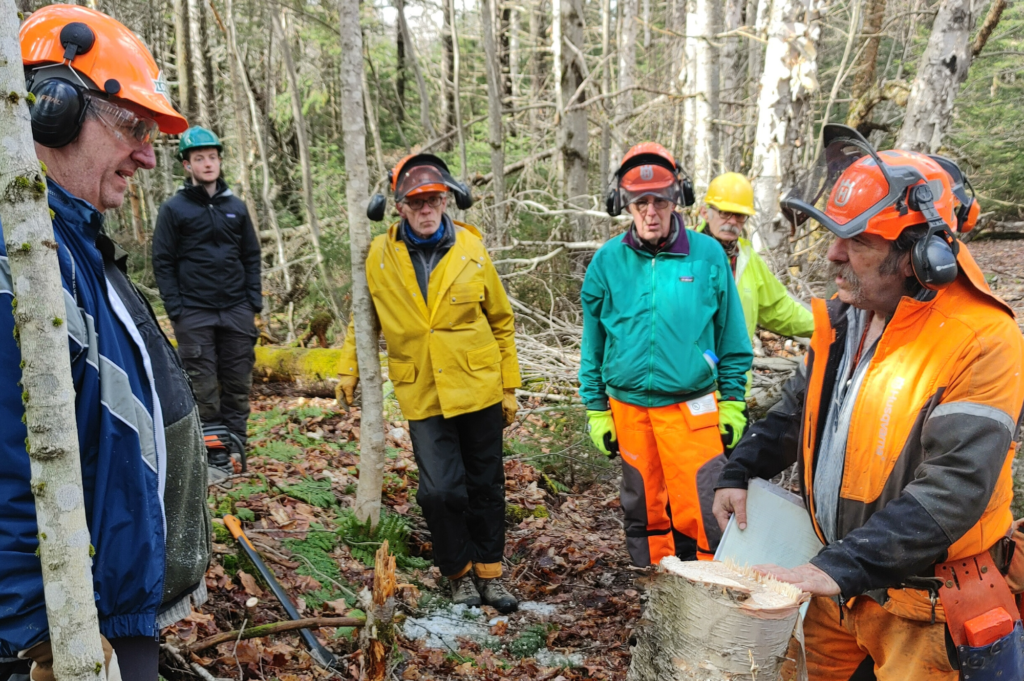
“In 200 yards, there were about 15 trees across the trail, each 18 to 20 inches in diameter,” recalls Bob Hagen, Trails and Shelters chair of GMC’s Upper Valley Ottauquechee (UVO) Section. The red spruce forest on the 46-mile stretch of Appalachian Trail that the UVO Section maintains is prone to blowdowns, he laughs.
As a section volunteer, Bob helps clear those downed trees. It’s why he asked GMC to organize training on chainsaw and crosscut saw safety. “It becomes a safety issue because [untrained] people take care of blowdowns casually so they can keep using the trails,” he says. Operating a saw doesn’t typically require a license, even though about 36,000 people are treated for chainsaw-related injuries each year, according to the CDC. That significant risk is why the U.S. Forest Service requires federal employees, cooperators, and volunteers to be certified before working with saws on its land: to maintain consistency and safety.
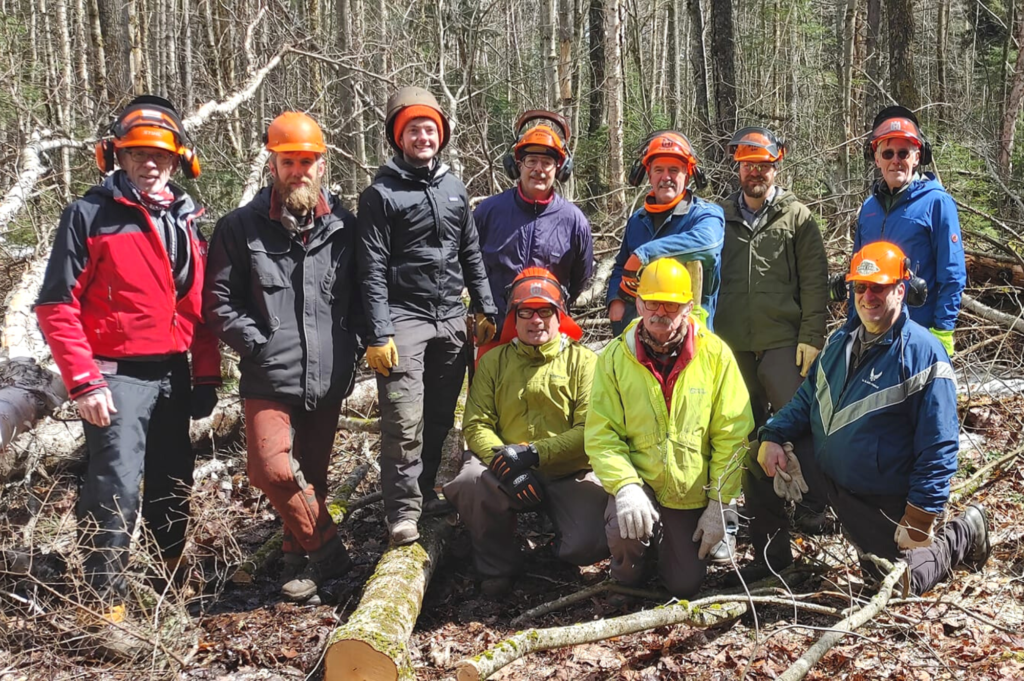
The certification requirement is important to GMC because eight sections and 154 adopters maintain trails and shelters on federal land, including the Green Mountain National Forest and the Appalachian National Scenic Trail, a unit of the National Park Service. Certification not only triggers insurance coverage for volunteers in case of damage or injury, but equips them to respond to blowdowns promptly and safely, explains GMC Volunteer Coordinator Lorne Currier.
“Providing regular chainsaw trainings is an important component to maintaining the Long Trail to appropriate standards, especially as climate change increases the frequency of high-wind and storm events,” says Lorne.
That’s where Northeast Woodland Training (NEWT) comes in. GMC hired NEWT co-owner David Birdsall to certify 30 of its volunteers this spring. David, a consulting forester and portable sawmill owner and operator, organizes and teaches continuing education to loggers, and directs the Vermont Logger Education to Advance Professionalism (LEAP) program, which certifies loggers in Vermont.
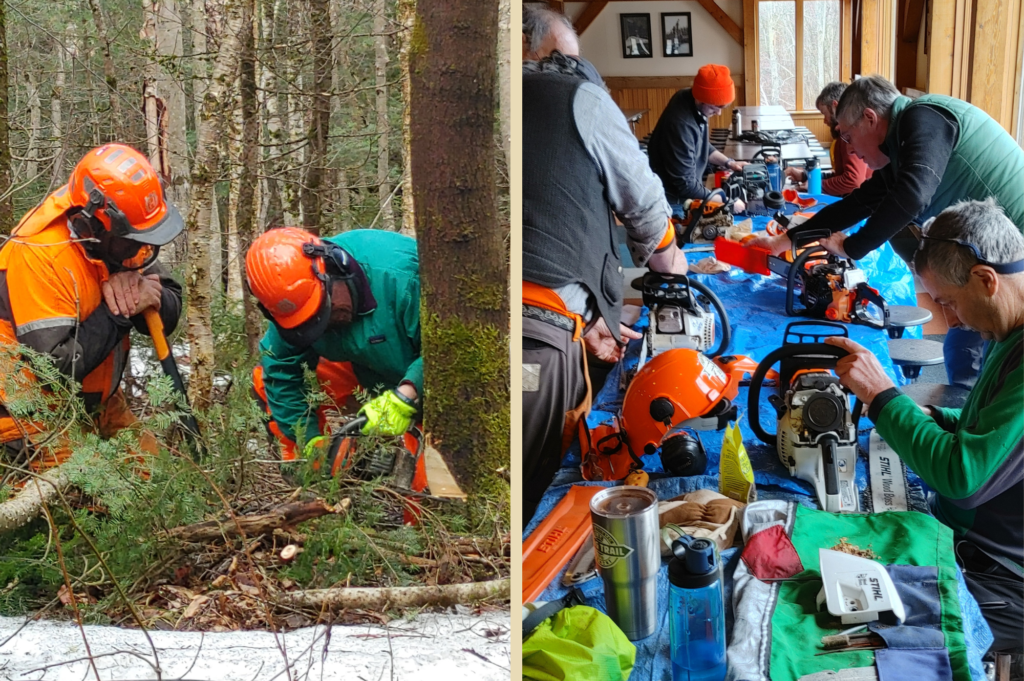
David uses the Game of Logging, a world-renowned curriculum, to teach chainsaw safety, efficiency, and productivity. The Game of Logging was developed in the 1960s by Swedish logger Soren Ericksson and is the oldest international sawyer training organization.
“No one in our training group had done the Game of Logging before,” says Peter Hildick-Smith, a Manchester Section volunteer. At the end of the three-day training, he and his peers demonstrate the concepts they’ve learned and practiced — including bucking (delimbing and cutting a downed tree into logs), safely cutting a heavily leaning tree, and felling a tree.
Some participants are foresters and loggers. Peter, however, is an amateur sawyer. He describes cutting down an apple tree on his property: “It was chaos in my mind. I’d owned a chainsaw for 20 years, but was clueless about how to use it safely.”
Understandably so. “For folks who are unfamiliar with a saw, there are a lot of physical forces that can catch them by surprise,” explains Keegan Tierney, GMC Director of Field Programs. Those forces aren’t just in the saw itself, which can kick back if its operator uses the wrong part of the bar.
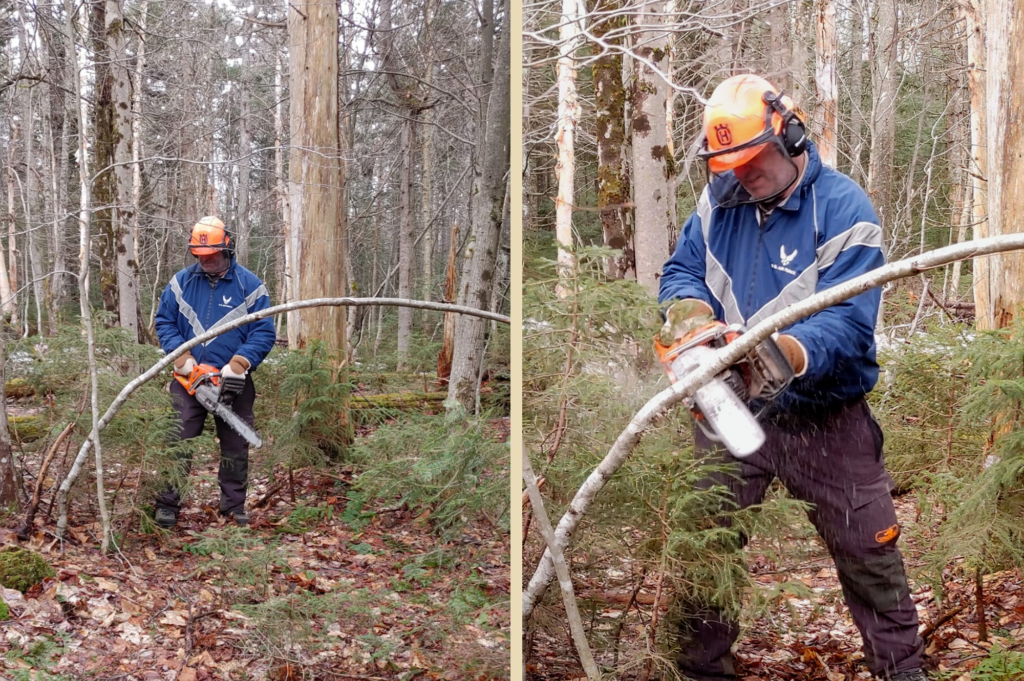
Wood is flexible and can move quickly, Keegan says. Think of a bent tree; it holds a lot of energy, not unlike a taut rubber band. Cut the rubber band, and it snaps back. “You can kill yourself with a two-inch maple sapling that’s bent the wrong way,” says Keegan. “Sawyer training teaches folks about these dangers and how to identify and mitigate them.”
Through the Game of Logging, GMC volunteers implement a five-point safety check on the chainsaw, plan an escape route, and fell a tree to hit a target. “It’s liberating to take this scary unknown and do it in a way that’s clearly defined. It’s very planned, very methodical,” says Peter.
The Forest Service saw certification, including CPR and First Aid, expires after three years. Just as an ordinary driver’s license won’t let you drive a semi-trailer truck, each certification level reflects a volunteer’s expertise. Most GMC volunteers are certified to use a saw without supervision on federal land. Keegan hopes to organize recertification courses each year.
Bob now has three certified sawyers in the UVO Section, so that red spruce forest should be less of a headache. “Regular trainings are a consistent and sustainable way to support volunteers,” he says.
Under the Helmet
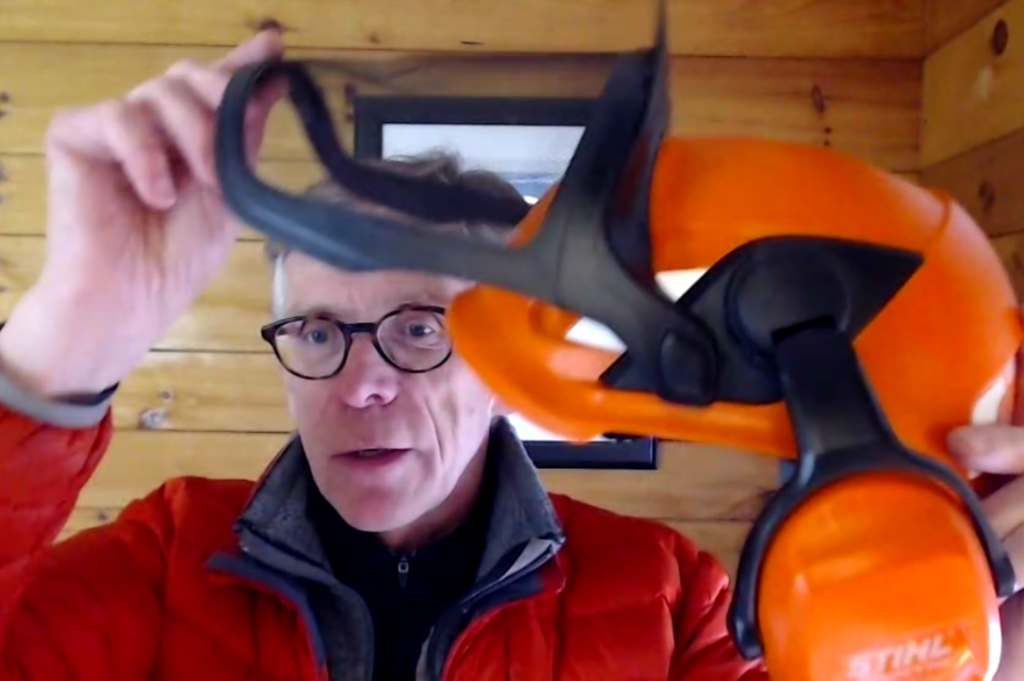
The safest way to run a chainsaw is at maximum speed, says Peter Hildick-Smith. He’s an amateur sawyer and slower to volunteer for demonstrations compared to his peers — some of whom are foresters and loggers by trade — at the Game of Logging sawyer training.
But on day three, Peter must demonstrate what he’s learned. He steps into a clearing and sizes up his assignment — a 12-inch-thick white birch that he must fell. The other volunteers look on while instructor David Birdsall holds a checklist and clipboard.
“I was a bit intimidated by these guys with newer equipment and much more experience. They had cut the trees in the clearing before me. Then you’re in the center, and everyone’s watching you while you try to remember all these concepts,” says Peter.
Under his orange helmet and visor, Peter’s adrenaline is pumping. He’s already doublechecked his saw to engage its five safety features. Now, he looks amid the canopy for vines, dead wood, and widowmakers that could obstruct the birch’s fall or cause an injury. He wants the hardwood tree to fall into the clearing, where it’ll be easier to piece. He sets a flagged stake where he hopes the tree will land.
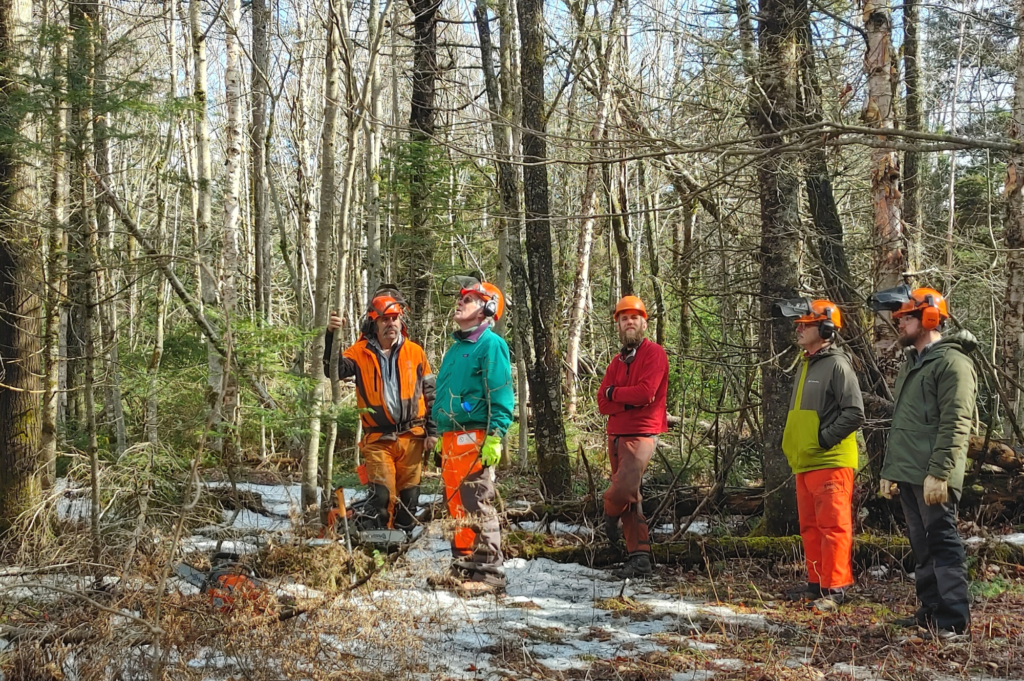
He then focuses on the tree. It’s relatively straight with a slight lean, its crown hovering 40 feet above the ground. He estimates its center of gravity and uses his observations to place another stake, which will help him aim his cuts.
Next, he plans his escape route. He’ll want to be 45 degrees opposite the direction of the falling tree, and more than 12 feet away. He clears branches and saplings in his route so he can make a quick leave. Now, it’s time to fell the tree.
He pulls the starter cord and the engine fires. Exhaust spews as Peter makes his initial cuts, and the saw’s roar reverberates through his protective equipment. “You’re aware of the noise and the speed of the chain. That overwhelms the senses more than anything else,” he says.
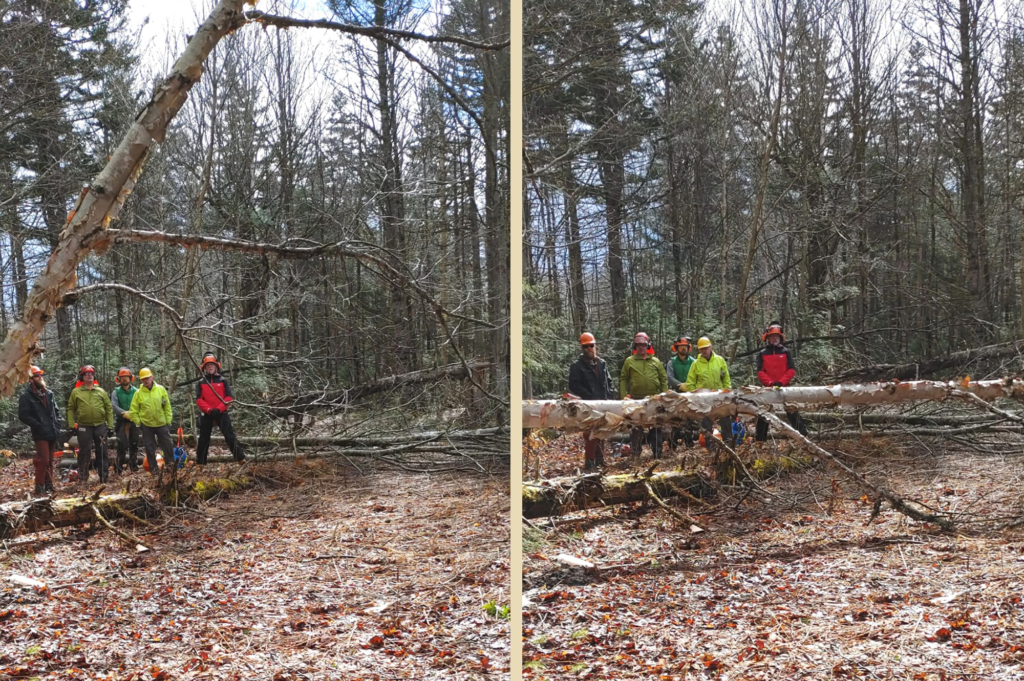
The cutting is technique driven. Initial cuts will aim the tree’s fall, but loggers leave a trigger, which, when cut, will bring the tree down in a controlled fashion. Until then, the tree is quite stable, says Peter.
“Clear!” He warns observers, scanning to ensure they are out of harm’s way. He then snips the trigger, turns off the saw, and heads for his escape route as practiced. The birch swishes slowly toward the ground, its branches softening its fall. The onlookers cheer as the scene settles. The birch has hit Peter’s target.
This post was written by Angela Hilsman, Communications Coordinator. It originally appeared in the Summer 2022 edition of the Long Trail News with the title “Volunteers Learn Sawyer Safety to Improve Trails.”
Related articles:



















Howdy, who is the person in charge of the trail where Governor Clements shelter located?
Hi, the Killington Section maintains this part of trail! You can also contact our Volunteer Coordinator Lorne Currier with any concerns (Info on the Staff page)